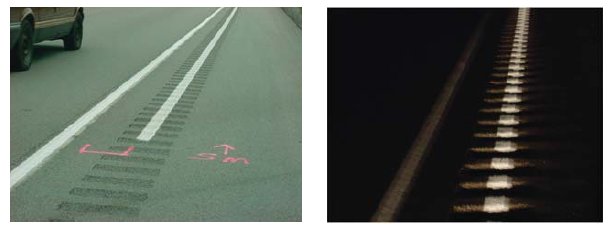U.S. Department of Transportation
Federal Highway Administration
1200 New Jersey Avenue, SE
Washington, DC 20590
202-366-4000
More than half (57 percent) of U.S. traffic fatalities occur after a driver crosses the edge or center line of a roadway. Two-thirds (65 percent) of these fatal crashes occur in rural areas.
Many factors contribute to drivers leaving the roadway or straying from their lane. These include driver fatigue and drowsiness; distracted driving; poor traction between vehicles and road surfaces and poor visibility in adverse weather conditions. Driver fatigue can occur when long, monotonous stretches of highway reduce the driver's concentration. These factors are sometimes compounded by driving too fast. Alcohol and drugs can contribute to both fatigue and speed.
Rumble strips create noise and vibration inside the vehicle that alert a driver as they cross the center or edge line. Often this alert is strong enough to get the attention of a distracted or drowsy driver, who can quickly make a corrective steering action to return to the roadway safely. Rumble strips also alert drivers to the lane limits when conditions such as rain, fog, snow, or dust reduce driver visibility.
Additional information is available via the Crash Modification Factors (CMF) Clearinghouse, which is an online repository of CMFs, along with supporting documentation, to help transportation engineers identify the most appropriate countermeasure for their safety needs.
Eleven states and one national study have analyzed the effectiveness of center line rumbles in reducing crashes. These studies conclude that crossover crashes were reduced 18 to 64 percent, with most studies showing 40 to 60 percent reductions.
On rural freeways, edge line rumble strips studies show that single vehicle run-off-road fatal and injury crashes can be reduced by nearly 29 percent (from NCHRP 641, p. 82).
Shoulder rumbles were first used on freeways, where their effectiveness has been studied extensively. Fourteen states and two multistate studies report reductions in single-vehicle run-off -road freeway crashes of 14 to 80 percent, with most reporting reductions in the 30 to 40 percent range. The three states that restricted their crash analysis to crashes caused by distracted or drowsy driving (the true target crashes for rumble strips) report 40 to 80 percent reduction in those crash types.
Rumble strips are effective for reducing roadway departure crashes associated with run-off-road and cross center line. Item 5 in each of the Technical Advisories contains information about the effectiveness of each type of rumble strip. FHWA Technical Advisory T 5040.40: Center Line Rumble Strips and FHWA Technical Advisory T 5040.39: Shoulder and Edge Line Rumble Strips.
A rumble strip becomes a "rumble stripe" when an edge line or center line pavement marking is placed on it. The profile of the marking within the rumble provides added nighttime visibility, particularly under dark, wet conditions. Nearby traffic tends to keep the rumble strip from filling with water, which allows the unobstructed portion of the pavement marking on the back wall of the rumble strip to reflect light back to the vehicle.

Rumble stripes daytime (left) and at night in the rain (right). Note the brightness of the rumble stripe at night, as compared to the normal pavement marking to the left of the rumble line. The double edge line is shown only for the purpose of comparing the two types. Michigan DOT (by permission)
